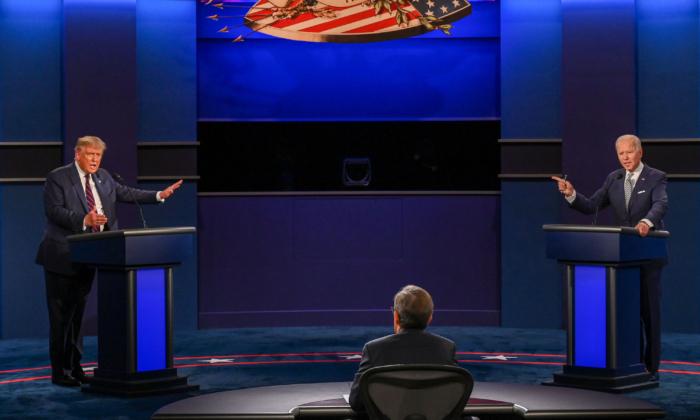From the perspective of an economist looking for clues from the first Trump–Biden debate, there were some important insights regarding the health care sector, energy policy, and the auto industry—but, surprisingly, we didn’t learn much about the candidates’ prospective trade policies.
On Sept. 29, President Donald Trump and former Vice President Joe Biden participated in the first of three debates sponsored by the Commission on Presidential Debates for the 2020 electoral season. I’m not qualified to discuss how the combative debate might help or hurt each candidate; there are others who are. And it will be important to understand those experts’ analyses, because this election isn’t just a choice between a low-tax, light-regulations incumbent (Trump) and a higher tax, more-regulations challenger (Biden).
It isn’t that simple. For example, the chances for a new stimulus package probably will go up if the Democrats gain a majority in the Senate and take over the White House. However, U.S. manufacturing would likely become less globally competitive if Biden were to win the presidency, and power prices would go up should he and a new Senate commit America to reducing carbon emissions under the Paris Agreement.
From what was discussed during the debate, it seems that Trump’s philosophy of light regulation may be speeding America toward COVID-19 treatments and maybe even a vaccine faster than the country otherwise might have been able to accomplish. During the debate, Trump mentioned the military’s ability to deploy 200,000 vaccines a day. He also mentioned conversations he has had with senior management at Johnson & Johnson, Pfizer, and Moderna, all of which are developing vaccines.
Also regarding health care, there was substantial discussion about the Affordable Care Act (ACA, also known as Obamacare). Many of us may have learned during the debate that the Supreme Court will soon take up a case being brought by the federal government as well as 18 state attorneys general to strike down the act. Investors would be wise to pay attention to this case.
Given what we know about the writings of Trump’s recent nominee to the Supreme Court—Judge Amy Coney Barrett is on record criticizing past judicial decisions upholding the ACA—that case will be important not only for the companies that have been hurt by the ACA, but also all those which have benefited from it.
Finally, there was also discussion about emissions standards on U.S.-manufactured cars. At least initially, it seems a continuation of Trump’s easier standards would likely benefit the companies that primarily build traditional carbon-burning cars. A Biden White House, it seems, may mean less profits, at least initially, for such companies.
However, there was little discussion about trade relations, where I was expecting some regarding China or at least the UK, which soon will be looking for free-trade partners as it exits the EU. Trade policy with China impacts companies with supply chains there as well as the entire U.S. agricultural industry—China is a major buyer of U.S. food products. U.S. policy toward trade with China will also impact which companies are likely to succeed or fail as the world builds out its 5G telecom networks. None of these topics were discussed.
Locally, an increase in global trade, especially across the Pacific region, is particularly important for the economies around the ports in San Pedro and Long Beach, California, as well as for trucking and other transport companies that move all those containers to the rest of America.
Debates can be interesting political theater and might sway elections. Investors are wise to consider not only how this debate might sway the upcoming election of Nov. 3, of course, but also how to position portfolios and make other decisions that reflect the true probabilities of the outcome. Ideally, a portfolio would be as robust as possible for all possible outcomes and provide the highest expected return for a given level of expected volatility, or the lowest possible volatility for a given desired expected rate of return.





